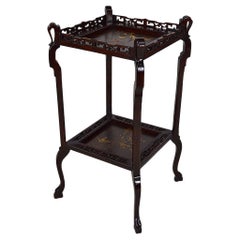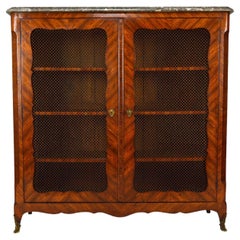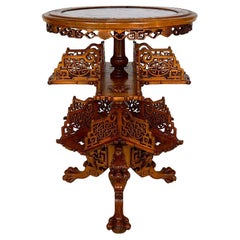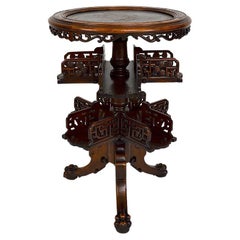Want more images or videos?
Request additional images or videos from the seller
1 of 21
Showcase with Inlaid Panels, attributed to Perret and Vibert, Japonisme, 1880
$7,686.09List Price
About the Item
- Attributed to:Perret et Vibert (Cabinetmaker)
- Dimensions:Height: 63 in (160 cm)Width: 28.35 in (72 cm)Depth: 16.15 in (41 cm)
- Style:Japonisme (Of the Period)
- Materials and Techniques:
- Place of Origin:
- Period:
- Date of Manufacture:circa 1880
- Condition:Refinished.
- Seller Location:VÉZELAY, FR
- Reference Number:1stDibs: LU6868230567462
About the Seller
5.0
Gold Seller
Premium sellers maintaining a 4.3+ rating and 24-hour response times
Established in 2017
1stDibs seller since 2022
44 sales on 1stDibs
Typical response time: 2 hours
Authenticity Guarantee
In the unlikely event there’s an issue with an item’s authenticity, contact us within 1 year for a full refund. DetailsMoney-Back Guarantee
If your item is not as described, is damaged in transit, or does not arrive, contact us within 7 days for a full refund. Details24-Hour Cancellation
You have a 24-hour grace period in which to reconsider your purchase, with no questions asked.Vetted Professional Sellers
Our world-class sellers must adhere to strict standards for service and quality, maintaining the integrity of our listings.Price-Match Guarantee
If you find that a seller listed the same item for a lower price elsewhere, we’ll match it.Trusted Global Delivery
Our best-in-class carrier network provides specialized shipping options worldwide, including custom delivery.You May Also Like
"Japonisme" Vitrine Attributed to A. Giroux, France, Circa 1880
By Maison Giroux
Located in PARIS, FR
Rare aesthetic movement showcase, opening in its upper part by two beveled glass doors framed by brass moldings, in its lower part by two door panels in carved walnut decorated with blooming branches and gilded bronze ornaments representing dragons and birds. The sides are carved, like wicker woven.
This showcase is topped by an important carved and gilded walnut cornice depicting a Fô Dog in its center, with a protective power, and rests on elephant head with overtuned trunk shaped feet.
This type of elephant head with overtuned trunk shaped feet is a characteristic of the Maison Giroux, which can be found on many objects they produced. Aesthetic movement cabinet, signed Maison Alphonse Giroux...
Category
Antique 1880s French Japonisme Vitrines
Materials
Bronze
$100,510
H 108.27 in W 65.75 in D 27.56 in
Japanese Style Cabinet-Secretary Att. to Perret & Vibert, France, circa 1880
By Perret et Vibert
Located in PARIS, FR
A Japanese style carved wood cabinet, with a painted decor imitating Japanese lacquer, ornamented with flowers, birds and butterflies. Opening onto two drawers and a paper filer, the upright-secretary door is also fitted with red velvet. Surmounted by a drawer and asymmetrical shelves, composed in the Japanese « zen » spirit, the cabinet stands on four legs joined by an engraved stretcher.
The great influence of the Far-East, through China and Japan, in the second half of the 19th century French art could be found first in painting and soon after in decorative arts and furniture as well.
Following the Franco-English military campaign led in 1860 against the Imperial army in China, the French troops of Napoleon III brought back from the Summer Palace, a part of the Chinese Imperial court treasure, which will make up the famous Chinese Museum of Empress Eugénie at the Fontainebleau Palace. The French artists won’t be long to take inspiration from those exotic and sumptuous objects for their creations, as they used to do in the 18th century, when the best French cabinet-makers adapted the Chinese lacquers on the luxurious royal chests.
But the influence of Japan, at the Meiji period (1868-1912), came also very quickly to France, thanks to the opening of the country in the middle of the 19th century, as well as the development of traveling and the amazing Universal Exhibitions, in which Japan participated for the first time in 1867 in Paris. Then many Japanese objects and prints were imported to France and to all Europe, and for which some collectors spent already fortunes.
With Manet and Impressionists generation, the passion for Japanese art, more than a simple taste for an exotic style, was still in fashion until the turn of the 19th century. It provoked not only a craze among the French aristocratic families as well as the wealthy Paris high society, wishing renew their mansion inner decoration, but turned also to a real revolutionary movement among the “avant-garde” artists. Those artists, whoever they were, painters, cabinet-makers or designers of ceramic, bronze and crystal objects, adapted then those techniques and naturalistic motifs unknown until this time.
Christofle, very famous since 1867 as a silversmith, was also one of the leaders among the inventors of Japanism. He knew how to use Japanese elements to his own splendid works made in silver or “cloisonné” enameled bronze. During the 1878 Paris Universal Exhibition, Christofle presented with great success his life-sized bronze Japanese ladies torcheres, executed by the renowned sculptor Guillemin.
Another famous company to be mentioned, is “L’Escalier de Cristal”, producing art objects and furniture, all of high standard quality and innovating much with their Japanese decor. Highly remarked during the Universal Exhibitions, “L’Escalier de Cristal” collaborated with the greatest artists, such Gallé and Rousseau for glass- and ceramic wares, and the cabinet-makers Lièvre and Viardot, whom made furniture including sometimes authentic Japanese elements.
In 1872, Alfred Perret and Ernest Vibert opened in Paris, at 33 rue du Quatre-Septembre a store that offered “natural bamboo furniture and cane seats” and all kinds of textile fittings for furniture. This furniture used for winter gardens and terraces of mansions knew then a resounding success. They developed their business around 1884 with their Japanese style furniture, very close to that executed by Gabriel Viardot (1830-1906). In 1886, the company appearing in the category of “Chinoiserie and Japoneries” offered, in addition to furniture and seating creation, works of art and inlaid furniture directly imported from the Far East ; an activity that expanded rapidly. Their exotic fantasy furniture presented at the Universal Exhibition of Paris in 1889 and 1900, rewarded them two silver medals. In 1894, the company was listed under the name “Perret et Vibert”, headed by the son of Alfred Perret and Ernest Vibert. The same year, they redesigned their store on rue du Quatre-Septembre, creating ten new show-rooms, showing complete furniture sets of Japanese and Chinese style inspiration. It was not until 1895, that the company was finally named “La Maison des Bambous” and organized then in their shops an “exhibition of country furniture and seats for castles and villas”, which was visited by Empress Eugenie to furnish her villa Cyrnos at Cap Martin. She actually was a regular customer of the “Maison des Bambous” as she bought repeatedly furniture. In October of the same year, the king of Greece...
Category
Antique 1880s French Japonisme Secretaires
Materials
Wood
$4,966
H 65.75 in W 25.6 in D 12.6 in
Japonisante Etagère in bamboo and lacquer attributed to Perret & Vibert, France
By Perret et Vibert
Located in Roma, RM
Japonisante Etagère in bamboo and lacquer attributed to Perret & Vibert, France late 19th century.
Product details
From the residence of Antonello Falqui – Falqui Collection.
Struc...
Category
Antique Late 19th Century Shelves
Materials
Bamboo, Wood
$4,635
H 53.55 in W 20.48 in D 11.82 in
French Art Nouveau Fruitwood Wooden Showcase Vitrine with Four Drawers
Located in Miami, FL
French fruitwood wooden showcase vitrine with four-drawer
Measures: Height to the drawers 33.46in.
Category
Early 20th Century French Art Nouveau Vitrines
Materials
Glass, Fruitwood
$6,500
H 80.11 in W 58.26 in D 22 in
Uncommon Italian Library Showcase in Walnut with Side Windows Restored
Located in Buggiano, IT
Uncommon Original Italian antique showcase bookcase, from a villa in the center of Bologna.
The cabinet has internal shelves, a very important upper gable, and is completely removabl...
Category
Antique 1870s Italian Rococo Vitrines
Materials
Walnut
$1,873 Sale Price
20% Off
H 96 in W 39.4 in D 17.3 in
Italian Bookcase Showcase in Solid Walnut, Bevelled Glass and Drawers
Located in Buggiano, IT
Italian bookcase showcase in solid walnut with four doors with ground glass and four drawers.
The glass top is detached from the base which has ano...
Category
Late 20th Century Italian Mid-Century Modern Bookcases
Materials
Walnut, Fir
$2,696 Sale Price
20% Off
H 92.13 in W 88.19 in D 19.69 in
Antique French Showcase Bookcase Louise Philippe, 1850s
Located in Traversetolo, IT
A beautiful French showcase from the Louis Philippe period of the 1850s.
This piece displays an outstanding executive quality due to the masterful ...
Category
Antique 1850s French Louis Philippe Vitrines
Materials
Crystal
$1,844 Sale Price
9% Off
H 89.38 in W 37.41 in D 18.9 in
Antique 19th Century Lacquered Etagere Perret And Vibert, France
By Perret et Vibert
Located in London, GB
Antique 19th Century Lacquered Etagere Perret And Vibert, France
C.1890
In very good condition commensurate of age.
Category
Antique 19th Century Japonisme Shelves
Materials
Fruitwood, Lacquer
$2,651
H 38.59 in W 21.66 in D 15.36 in
18th-19th Century Swedish Baroque Pinewood, Glass Bookcase, Antique Showcase
Located in West Palm Beach, FL
A light-grey, antique large Swedish Baroque two-part bookcase made of hand crafted painted Pinewood, in good condition. The upper part of the detailed Scandinavian library, showcase is composed with two doors featuring its original glass and two long arched shelves...
Category
Antique Late 18th Century Swedish Baroque Bookcases
Materials
Metal, Chrome
$22,900
H 87.75 in W 66.5 in D 18.5 in
Japonisme Mother of Pearl Inlaid Hardwood Display Cabinet after Viardot
By Gabriel Viardot
Located in London, GB
This wonderful display cabinet is designed in a ‘Japonisme’ (Japanese) style, which was popular in Europe in the mid-late 19th century. This craze was kick-started by Japan reopening to trade with the West, and exporting Japanese goods—including furniture and decorative art—to Europe. One craftsmen by the name of Gabriel Viardot (1830-1906) established a name for himself in France producing Chinese and Japanese style furniture...
Category
Antique Late 19th Century French Japonisme Furniture
Materials
Metal
$11,559
H 76.38 in W 23.63 in D 12.6 in
More From This Seller
View AllPedestal Table in Carved Wood and Lacquered Panels, Japonisme France, circa 1880
By Perret et Vibert
Located in VÉZELAY, FR
Superb pedestal table / gueridon / side table in carved wood whose feet end in hooves.
Presence of 2 lacquered Asian-inspired trays with animal and plant scenes: birds, insects, flowers...
In excellent condition, restored.
Art Nouveau Japonism, France, around 1880-1890.
Attributed to the Maison des Bambous / Alfred Perret and Ernest Vibert.
Founded in 1879 in Paris, the Maison des Bambous specializes in the production of bamboo furniture, luxury basketry, the importation of authentically Japanese...
Category
Antique 1880s French Japonisme Side Tables
Materials
Wood
$2,364 Sale Price
20% Off
Louis XV Bookcase by Pierre Garnier with Inlay Wood and Marble Top, circa 1750
Located in VÉZELAY, FR
Superb inlaid bookcase / vitrine / showcase with very thick marble top, feet decorated with bronze and double mesh door. 3 shelves present.
In excellent general condition.
Key present, the lock works perfectly
Louis XV style and period, France, 18th century, around 1750.
By the cabinetmaker Pierre Garnier...
Category
Antique Mid-18th Century French Louis XV Bookcases
Materials
Marble, Bronze
$26,605 Sale Price
25% Off
Swivel Bookcase Table with Marble Top by Gabriel Viardot, Japonism, circa 1880
By Gabriel Viardot
Located in VÉZELAY, FR
Rare pedestal table / bookcase in Japanese / Chinese / Asian style, richly carved.
With red marble top, swivel shelves and tripod base carved with dragon / demon heads and clawed le...
Category
Antique 1880s French Japonisme Bookcases
Materials
Marble
$3,310 Sale Price
20% Off
Swivel Bookcase Table with Carved Top by Gabriel Viardot, Japonism, circa 1880
By Gabriel Viardot
Located in VÉZELAY, FR
Rare pedestal table / bookcase in Japanese / Chinese / Asian style.
Richly carved : top decorated with a dragon, openwork swivel shelves and tripod base carved with clawed legs.
Ar...
Category
Antique 1880s French Japonisme Bookcases
Materials
Wood
$2,837 Sale Price
20% Off
Art Deco display cabinet / showcase / bookcase in walnut, France, Circa 1920
By Maurice Dufrêne, Paul Follot
Located in VÉZELAY, FR
Cabinet / display case / bookcase with glass door, in walnut.
In the style of the productions of Follot, Dufrène.
Art Deco.
France, Circa 1920.
Carved fruit baskets on the door.
Pr...
Category
Vintage 1920s French Art Deco Vitrines
Materials
Glass, Wood, Walnut
$3,121 Sale Price
20% Off
Art Deco display cabinet / showcase / bookcase in walnut, France, Circa 1920
By Maurice Dufrêne, Paul Follot
Located in VÉZELAY, FR
Cabinet / display case / show case / bookcase with glass door, in walnut.
In the style of the productions of Follot, Dufrène.
Art Deco.
France, Circa 1920.
Carved fruit baskets on...
Category
Vintage 1920s French Art Deco Vitrines
Materials
Glass, Wood, Walnut
$2,837 Sale Price
20% Off
Recently Viewed
View AllMore Ways To Browse
Perret Et Vibert
Perret And Vibert
Maison Des Bambous
Maison Perret
Corner Cabinet Dining Room
Bombe Vitrine
Glass Case Display Table
Iron Medical Cabinet
Antique Glass Display Table
German Display Cabinet
Small Vitrine
Mahogany Vitrine English
Medical Vitrine
Vitrine With Mirror
Giltwood Display Cabinet
Louis Curio
Baroque Display Cabinet
Mastercraft Brass Vitrine



